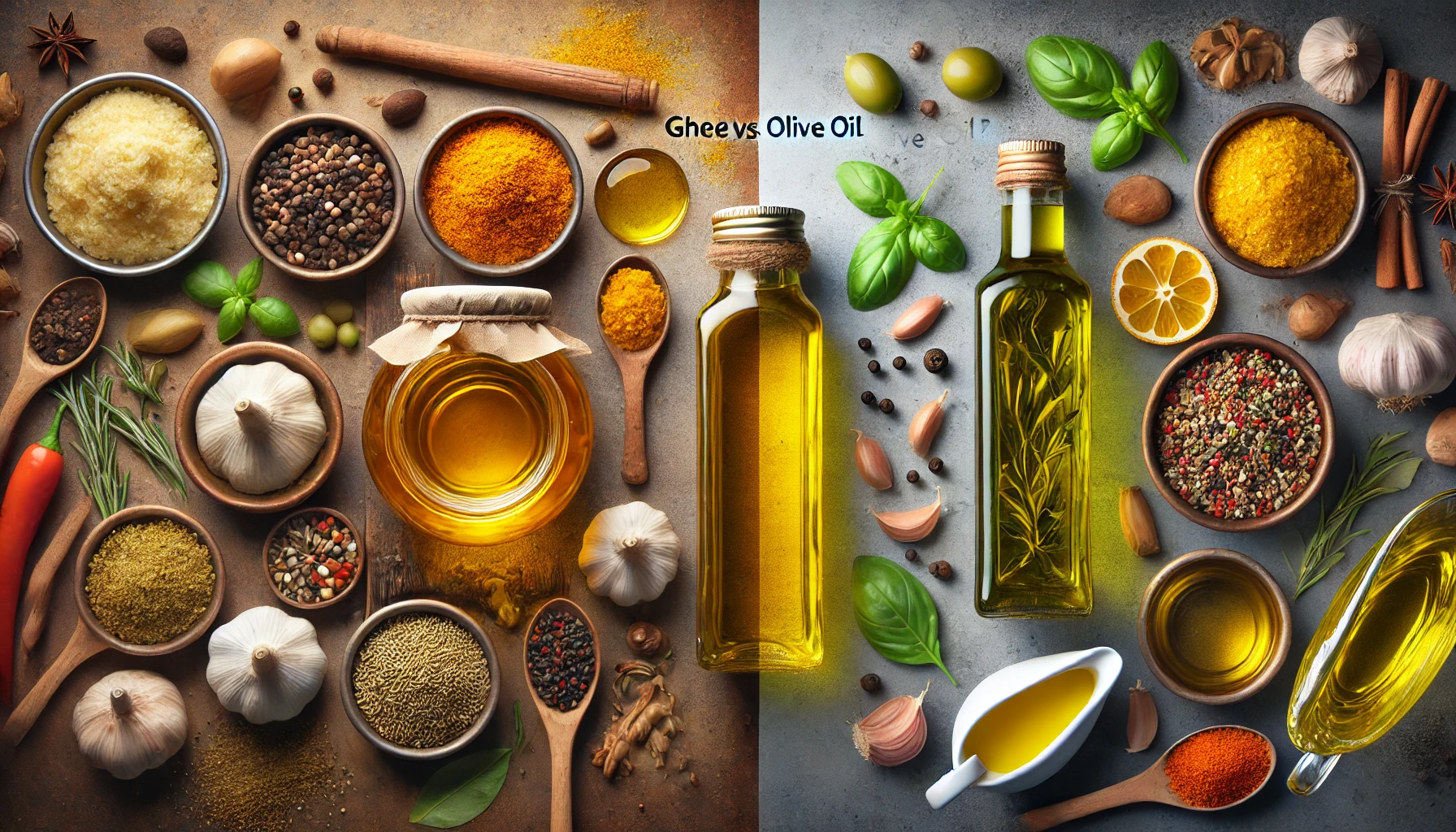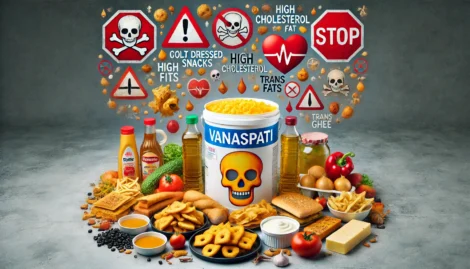- You have no items in your shopping cart
- Subtotal: ₹0.00

Why Ghee Might Be Better Than Olive Oil for Indian Cooking
Ghee vs Olive Oil: In the modern health-conscious world, oils and fats are no longer seen just as cooking mediums. They have gained much attention due to their nutrient profiles, health benefits, and impact on overall well-being. Olive oil has earned the title of “superfood,” being recommended by health experts for its rich antioxidant content and heart-healthy fats. However, when it comes to Indian cooking, which often requires high temperatures and long cooking times, olive oil may not always be the best option. This is where ghee, a traditional Indian fat, could be a more appropriate choice.
In this article, we’ll compare the uses and benefits of ghee and olive oil, especially in the context of Indian cooking. By understanding their differences in terms of smoke points, nutrient profiles, flavor, and culinary applications, you’ll have a clearer picture of why ghee may be a superior choice for Indian cuisine.
What is Ghee?
Ghee is a type of clarified butter that has been an integral part of Indian culture and cooking for centuries. It is made by simmering butter to separate the milk solids and water, leaving behind a rich, golden liquid known as ghee. This process removes lactose and casein, making ghee a suitable option for those with lactose intolerance or dairy sensitivities.
Key Characteristics of Ghee:
- High Smoke Point: Ghee has a smoke point of 450°F (232°C), which makes it ideal for frying, sautéing, and deep-frying—common cooking techniques in Indian cuisine.
- Rich in Nutrients: Ghee contains healthy fats like butyrate, which supports gut health, and fat-soluble vitamins A, D, E, and K.
- Digestive Health: Ghee is believed to aid digestion, and in Ayurveda, it is often used for its detoxifying properties.
- Flavor Enhancer: Ghee imparts a rich, nutty flavor to dishes and enhances the aroma of spices when used in tempering.
What is Olive Oil?
Olive oil, derived from olives, is a staple in Mediterranean cuisine and has gained popularity worldwide due to its health benefits. It is rich in monounsaturated fats, antioxidants like polyphenols, and vitamin E, which are known to support heart health and reduce inflammation.
Key Characteristics of Olive Oil:
- Smoke Point: The smoke point of extra virgin olive oil is about 320°F (160°C), making it unsuitable for high-heat cooking like deep-frying.
- Nutrient Density: Olive oil is high in antioxidants and monounsaturated fats, which are beneficial for heart health.
- Versatility: Olive oil is often used in raw applications like salad dressings and drizzling over finished dishes, as its delicate flavor profile complements a wide range of cuisines.
The Importance of Smoke Point in Indian Cooking
One of the major differences between ghee and olive oil is their smoke point—the temperature at which the oil or fat begins to break down, releasing harmful compounds and free radicals. In Indian cooking, where high heat is often required, particularly in techniques like frying, deep-frying, and tempering (tadka), the smoke point is crucial.
Why Does Smoke Point Matter?
When an oil exceeds its smoke point, it not only loses its nutritional value but also becomes unhealthy to consume. The oil begins to oxidize, producing free radicals that can contribute to chronic diseases, including heart disease and cancer.
- Ghee’s Smoke Point: 450°F (232°C)
- Extra Virgin Olive Oil’s Smoke Point: 320°F (160°C)
- Regular Olive Oil’s Smoke Point: 465°F (240°C)
While regular olive oil can withstand higher heat, it is often more refined and lacks the nutrient density of extra virgin olive oil. On the other hand, ghee maintains both a high smoke point and a rich nutrient profile, making it the ideal choice for most Indian cooking techniques.
Ghee vs Olive Oil in Indian Cooking: A Comparison
1. High-Heat Cooking
Indian cooking is known for its high-heat techniques like frying, sautéing, and tempering. Dishes like pakoras, samosas, poor bhaji, and parathas all require oil or fat that can handle high temperatures without breaking down.
- Ghee: With a high smoke point, ghee is perfect for high-heat cooking. It doesn’t burn easily, and its rich flavor enhances the spices used in Indian cuisine.
- Olive Oil: Extra virgin olive oil has a lower smoke point, which makes it unsuitable for high-heat cooking. Using it at high temperatures can lead to the release of toxic compounds. While regular olive oil has a higher smoke point, it lacks the full nutrient profile of extra virgin olive oil.
2. Flavor and Aroma
Indian cuisine is celebrated for its aromatic spices, which are often bloomed in hot oil or ghee to release their essential oils and enhance the dish’s overall flavor.
- Ghee: Ghee is deeply flavorful, with a nutty, caramelized taste that complements Indian spices like cumin, mustard seeds, and coriander. It enhances the taste and aroma of traditional dishes like dal tadka and khichdi.
- Olive Oil: Olive oil has a mild flavor that doesn’t pair as well with traditional Indian spices. While it can be used in fusion dishes or salads, it doesn’t provide the same depth of flavor needed for many Indian recipes.
3. Nutritional Profile
Both ghee and olive oil offer a variety of health benefits, but their nutritional compositions are quite different.
- Ghee: Rich in short-chain fatty acids, including butyrate, which supports gut health, ghee also contains omega-3 fatty acids and fat-soluble vitamins. Ghee’s fat content can help in absorbing nutrients from vegetables, making it a nutritious choice for Indian meals.
- Olive Oil: Olive oil, particularly extra virgin olive oil, is high in monounsaturated fats and antioxidants like polyphenols, which are known for their anti-inflammatory and heart-healthy benefits. However, these nutrients are best retained when olive oil is used in raw or low-heat cooking.
4. Digestibility and Gut Health
In Ayurveda, ghee is considered one of the best fats for digestion and is often used for detoxification and medicinal purposes.
- Ghee: Ghee is known for its digestive properties. It stimulates the secretion of stomach acids, aiding digestion, and is believed to support the healing of the gut lining, making it a popular choice for individuals with digestive issues.
- Olive Oil: Olive oil is also known for its digestive benefits, particularly its ability to reduce inflammation in the gut. However, its effectiveness is most potent when used raw or in low-heat applications.
5. Shelf Life and Storage
Both ghee and olive oil require specific storage conditions to maintain their freshness and quality.
- Ghee: One of the benefits of ghee is that it has a long shelf life. Unlike butter, ghee does not spoil quickly and can be stored at room temperature for extended periods, making it ideal for Indian households.
- Olive Oil: Olive oil is more prone to oxidation, especially when exposed to light, heat, and air. It is best stored in a cool, dark place and used within a few months to retain its flavor and nutrients.
Ghee in Traditional Indian Dishes
Let’s take a look at some traditional Indian dishes where ghee truly shines:
- Dal Tadka: A staple in Indian cuisine, dal tadka involves tempering spices in ghee to enhance the flavors of the lentils. The rich aroma of ghee brings out the earthy notes of the dal and spices, making it a comforting and nutritious dish.
- Parathas: Ghee is often used to cook and baste parathas (Indian flatbreads), giving them a flaky, golden texture. The high smoke point of ghee ensures that the parathas don’t burn and remain crisp on the outside and soft on the inside.
- Sweets: Ghee is an essential ingredient in many Indian sweets, such as halwa, ladoos, and barfis. Its richness and depth of flavor enhance the taste of these festive treats.
Olive Oil in Indian Fusion Dishes
While ghee remains the traditional choice for most Indian dishes, olive oil can also be used in fusion cuisine, where Indian flavors are combined with Western techniques. For example:
- Mediterranean-Indian Salad: A salad made with Indian spices, chickpeas, and greens can be drizzled with extra virgin olive oil for a fresh, healthy dish.
- Grilled Tandoori Vegetables: Olive oil can be used to marinate vegetables with tandoori spices before grilling, offering a lighter alternative to traditional frying methods.
Scientific Studies on Ghee vs Olive Oil
1. Ghee and Heart Health
A study published in the journal Ayurveda and Integrative Medicine found that moderate consumption of ghee, when included in a balanced diet, does not raise cholesterol levels. In fact, ghee contains butyric acid, which has anti-inflammatory properties and supports gut health.
2. Olive Oil and Cardiovascular Benefits
Olive oil has been extensively studied for its cardiovascular benefits. A study in The New England Journal of Medicine found that a Mediterranean diet rich in olive oil reduces the risk of heart disease, stroke, and diabetes. However, the study emphasized using olive oil in raw or low-heat cooking, as high temperatures can degrade its beneficial compounds.
Conclusion: Is Ghee Better Than Olive Oil for Indian Cooking?
While both ghee and olive oil have their unique health benefits, ghee is the clear winner when it comes to Indian cooking. Its high smoke point, rich flavor, and traditional use in Indian cuisine make it the ideal fat for high-heat cooking techniques like frying, sautéing, and tempering. Ghee’s nutrient profile, including its healthy fats and fat-soluble vitamins, also makes it a nutritious choice for Indian households.
Olive oil, on the other hand, is best suited for low-heat cooking or raw applications. It is an excellent choice for salad dressings, drizzling over cooked vegetables, and making Mediterranean-inspired dishes. However, it may not be the best option for Indian cuisine, where high-heat cooking is more prevalent.
For the best of both worlds, you can include both ghee and olive oil in your diet, using each in the appropriate cooking method to maximize flavor and health benefits.



